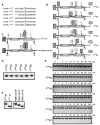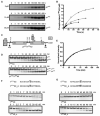The precise sequence of FGF receptor autophosphorylation is kinetically driven and is disrupted by oncogenic mutations
- PMID: 19224897
- PMCID: PMC2755185
- DOI: 10.1126/scisignal.2000021
The precise sequence of FGF receptor autophosphorylation is kinetically driven and is disrupted by oncogenic mutations
Abstract
Autophosphorylation of the tyrosine kinase domain of fibroblast growth factor receptor 1 (FGFR1) is mediated by a sequential and precisely ordered three-stage autophosphorylation reaction. First-stage autophosphorylation of an activation loop tyrosine leads to 50- to 100-fold stimulation of kinase activity and is followed by second-stage phosphorylation of three additional tyrosine residues, which are binding sites for signaling molecules. Finally, third-stage phosphorylation of a second activation loop tyrosine leads to an additional 10-fold stimulation of FGFR1 catalytic activity. In this report, we show that sequential autophosphorylation of five tyrosines in the FGFR1 kinase domain is under kinetic control, mediated by both the amino acid sequence surrounding the tyrosines and their locations within the kinase structure, and, moreover, that phosphoryl transfer is the rate-limiting step. Furthermore, the strict order of autophosphorylation is disrupted by a glioblastoma-derived, oncogenic FGFR1 point mutation in the kinase domain. We propose that disrupted stepwise activation of tyrosine autophosphorylation caused by oncogenic and other activating FGFR mutations may lead to aberrant activation of and assembly of signaling molecules by the activated receptor.
Figures





Similar articles
-
Autophosphorylation of FGFR1 kinase is mediated by a sequential and precisely ordered reaction.Mol Cell. 2006 Mar 3;21(5):711-7. doi: 10.1016/j.molcel.2006.01.022. Mol Cell. 2006. PMID: 16507368
-
Fibroblast growth factor receptor 1 (FGFR1) tyrosine phosphorylation regulates binding of FGFR substrate 2alpha (FRS2alpha) but not FRS2 to the receptor.Mol Endocrinol. 2008 Jan;22(1):167-75. doi: 10.1210/me.2007-0140. Epub 2007 Sep 27. Mol Endocrinol. 2008. PMID: 17901128 Free PMC article.
-
Different tyrosine autophosphorylation requirements in fibroblast growth factor receptor-1 mediate urokinase-type plasminogen activator induction and mitogenesis.Mol Biol Cell. 1999 Jan;10(1):23-33. doi: 10.1091/mbc.10.1.23. Mol Biol Cell. 1999. PMID: 9880324 Free PMC article.
-
Asymmetric tyrosine kinase arrangements in activation or autophosphorylation of receptor tyrosine kinases.Mol Cells. 2010 May;29(5):443-8. doi: 10.1007/s10059-010-0080-5. Epub 2010 Apr 28. Mol Cells. 2010. PMID: 20432069 Review.
-
Heparan sulfate fibroblast growth factor receptor complex: structure-function relationships.Mol Reprod Dev. 1994 Sep;39(1):69-81; discusison 81-2. doi: 10.1002/mrd.1080390112. Mol Reprod Dev. 1994. PMID: 7999363 Review.
Cited by
-
Macrophage proliferation is regulated through CSF-1 receptor tyrosines 544, 559, and 807.J Biol Chem. 2012 Apr 20;287(17):13694-704. doi: 10.1074/jbc.M112.355610. Epub 2012 Feb 28. J Biol Chem. 2012. PMID: 22375015 Free PMC article.
-
Temporal resolution of autophosphorylation for normal and oncogenic forms of EGFR and differential effects of gefitinib.Biochemistry. 2012 Jun 26;51(25):5212-22. doi: 10.1021/bi300476v. Epub 2012 Jun 13. Biochemistry. 2012. PMID: 22657099 Free PMC article.
-
Targeting Cellular Trafficking of Fibroblast Growth Factor Receptors as a Strategy for Selective Cancer Treatment.J Clin Med. 2018 Dec 20;8(1):7. doi: 10.3390/jcm8010007. J Clin Med. 2018. PMID: 30577533 Free PMC article. Review.
-
Molecular and clinical significance of fibroblast growth factor 2 (FGF2 /bFGF) in malignancies of solid and hematological cancers for personalized therapies.Oncotarget. 2016 Jul 12;7(28):44735-44762. doi: 10.18632/oncotarget.8203. Oncotarget. 2016. PMID: 27007053 Free PMC article. Review.
-
Fibroblast Growth Factor Receptor Functions in Glioblastoma.Cells. 2019 Jul 13;8(7):715. doi: 10.3390/cells8070715. Cells. 2019. PMID: 31337028 Free PMC article. Review.
References
-
- Furdui CM, Lew ED, Schlessinger J, Anderson KS. Autophosphorylation of FGFR1 kinase is mediated by a sequential and precisely ordered reaction. Mol. Cell. 2006;21:711–717. - PubMed
-
-
Abbreviations for the amino acid residues are as follows:Ala A, Cys C, Asp D, Glu E, Phe F, Gly G, His H, Ile I, Lys K, Leu L, Met M, Asn N, Pro P, Gln Q, Arg R, Ser S, Thr T, Val V, Trp W, Tyr Y. X represents any amino acid.
-
-
- Dickens M, Tavaré JM. Analysis of the order of autophosphorylation of human insulin receptor tyrosines 1158, 1162 and 1163. Biochem. Biophys. Res. Commun. 1992;186:244–250. - PubMed
-
- Wei L, Hubbard SR, Hendrickson WA, Ellis L. Expression, characterization, and crystallization of the catalytic core of the human insulin receptor protein-tyrosine kinase domain. J. Biol. Chem. 1995;270:8122–8130. - PubMed
-
- Favelyukis S, Till JH, Hubbard SR, Miller WT. Structure and autoregulation of the insulin-like growth factor 1 receptor kinase. Nat. Struct. Biol. 2001;8:1058–1063. - PubMed
MeSH terms
Substances
Grants and funding
LinkOut - more resources
Full Text Sources
Other Literature Sources
Molecular Biology Databases
Miscellaneous

